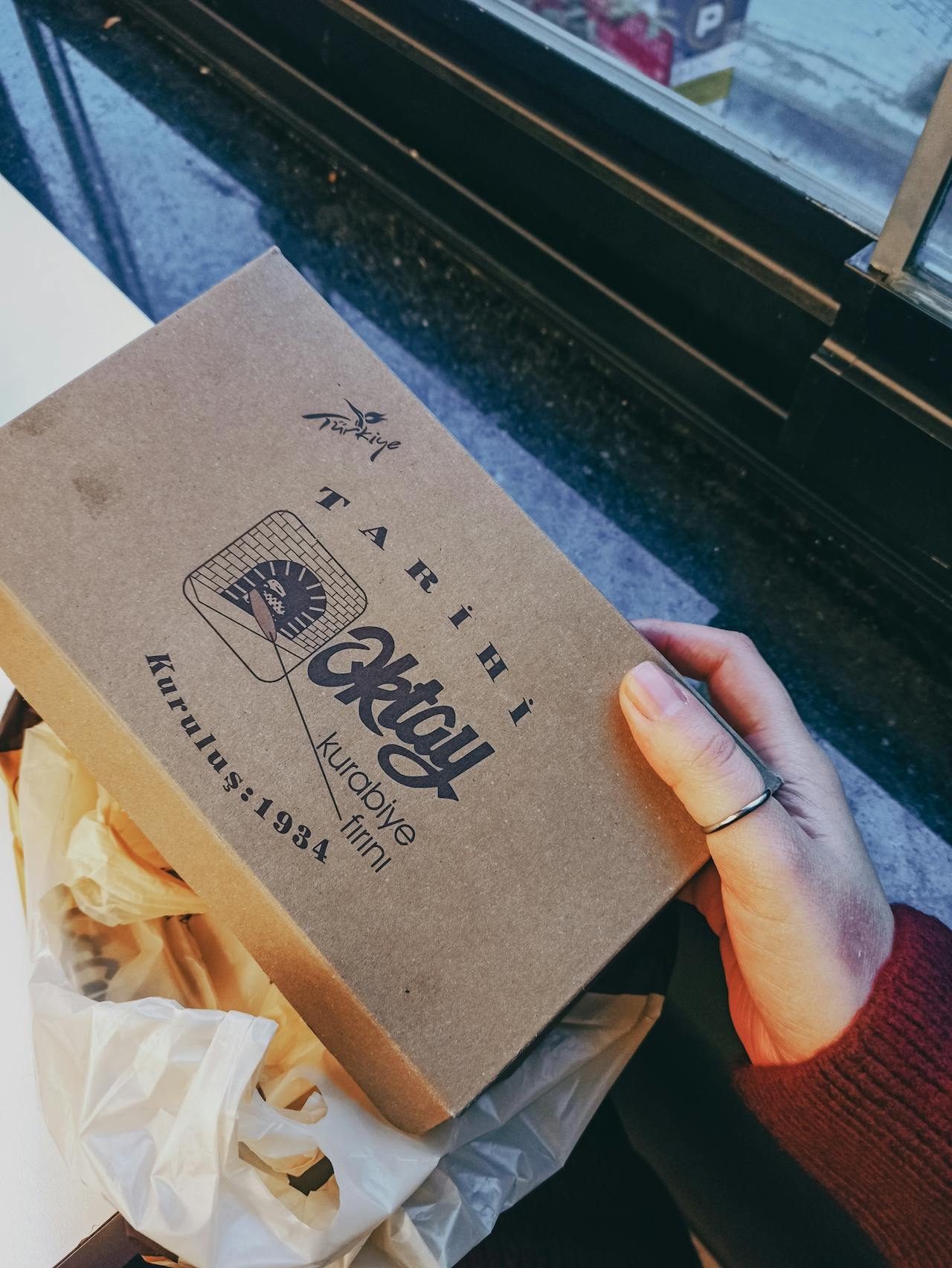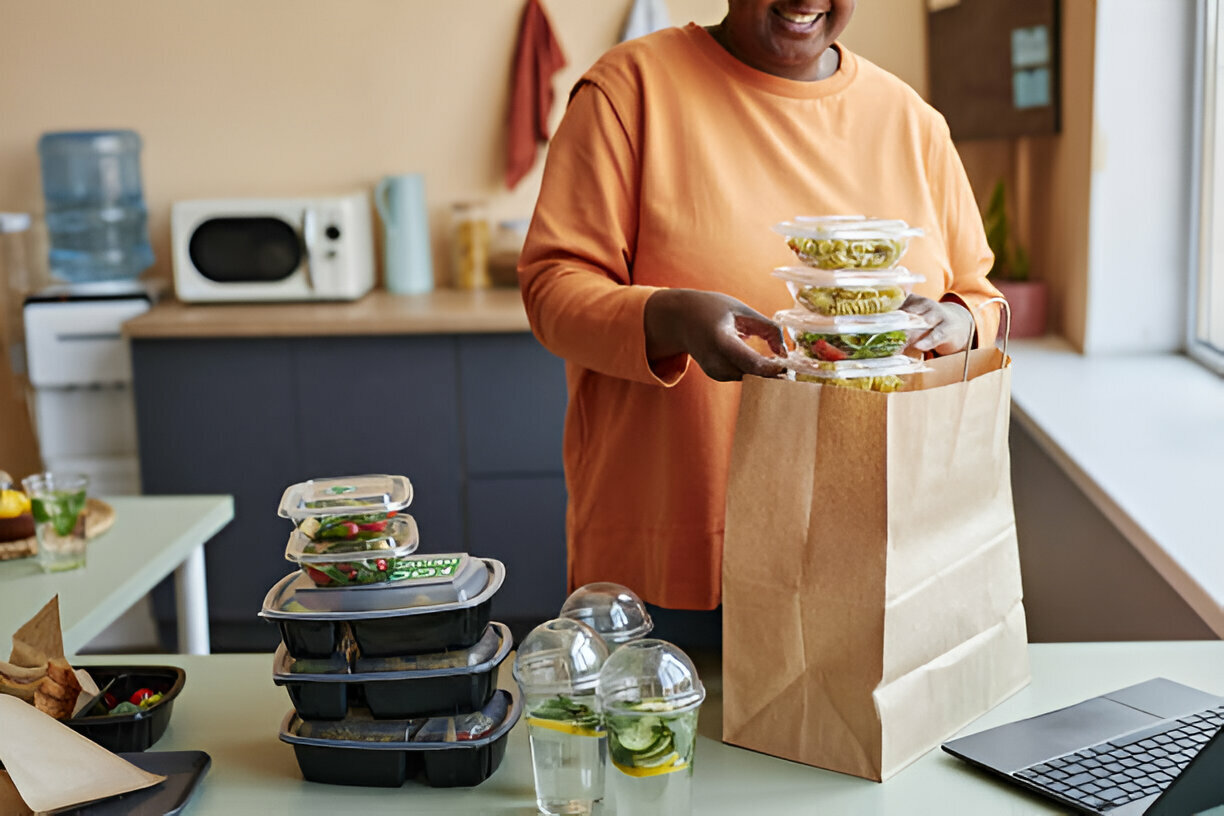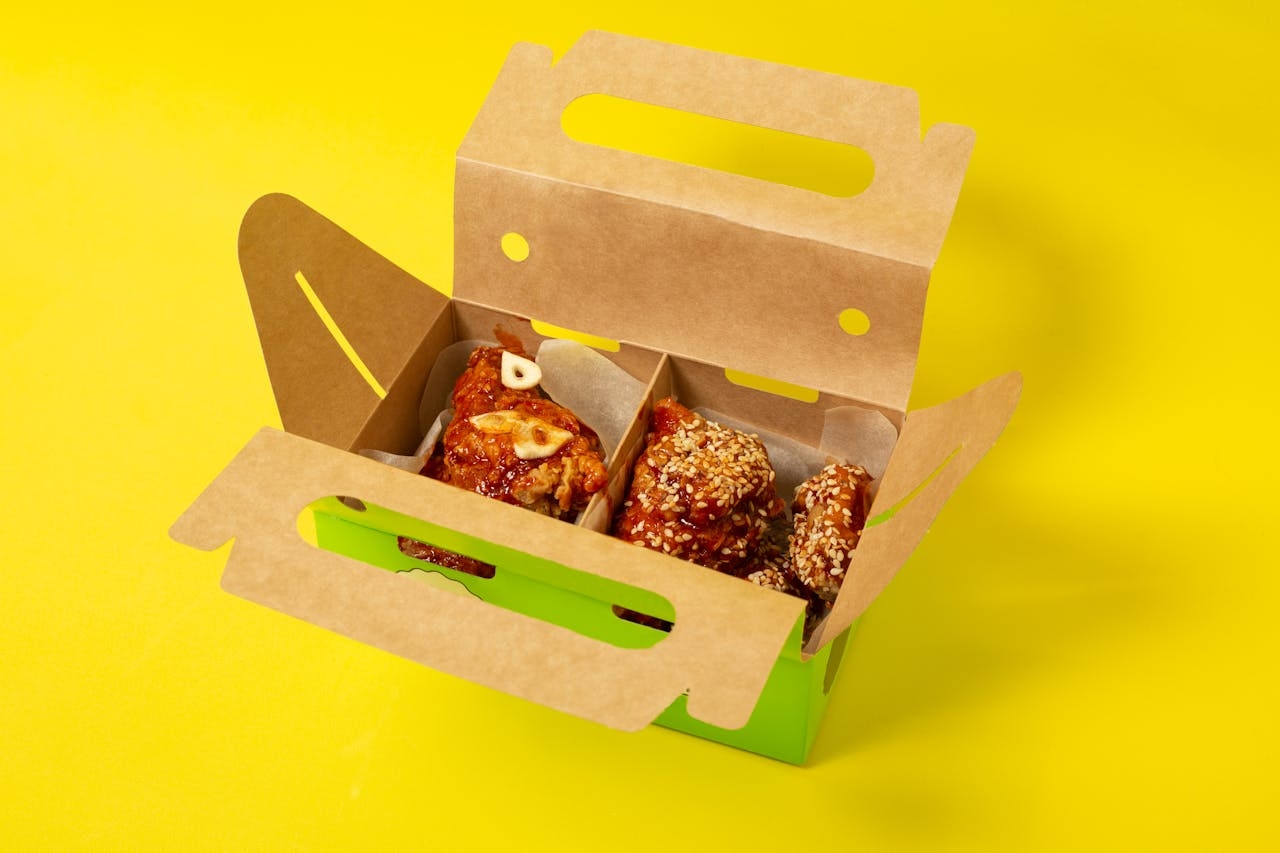Takeaway Packaging Strategies for Sustainable Brands
By Anttoni Taimela · 7. June 2024
Are you seeking sustainable takeaway packaging strategies that align with your brand, appeal to eco-conscious customers, and maintain the integrity of your dishes?
Efficient takeaway packaging is a crucial element for food businesses aiming to minimize their environmental impact while enhancing consumer appeal and ensuring product quality.
This article dives into the best practices for selecting eco-friendly materials, customising designs, balancing costs with sustainability, and leveraging innovative technologies to keep your hot and cold dishes perfectly preserved en route to your customers.
Crafting a Sustainable Brand Image with Eco-Friendly Takeaway Packaging
 Takeaway Food in Paper Box
Takeaway Food in Paper Box
Imagine a world where every takeaway box tells a tale, not of deforestation or ocean pollution, but of a brand’s valiant quest for sustainability.
Such eco-friendly narratives are becoming increasingly crucial in the food industry, where the choice of packaging materials can either garnish a brand’s image with green laurels or leave it in the murky waters of environmental neglect.
It’s no secret that today’s consumers are akin to knights in ecological armour, seeking to ally with establishments that wield sustainable practices as their weapons of choice. 🛡️
And what better way to joust against the dragons of plastic pollution than by brandishing eco-friendly packaging that not only protects our planet but also fortifies customer allegiance?
By engaging in a noble pursuit of a sustainable future, restaurants and food delivery services not only enhance their brand identity but also plant the seeds of loyalty in the fertile soils of their customer base. 🌱
Enhancing Customer Loyalty through Green Initiatives
The heart of a customer is won by consistent acts of environmental kindness. When a brand wraps its takeaway food in sustainable packaging, it wraps the consumer in a warm embrace of trust and shared values.
This green ribbon of connection is not easily severed; it grows stronger with every eco-friendly option, with every sustainable takeaway packaging chosen over its less planet-friendly counterparts.
In a world where every choice carries weight, brands that tip the scales towards sustainable alternatives find themselves not just participating in the race towards a more sustainable future but leading the pack, with a loyal following cheering them on.
Selecting the Right Sustainable Materials for Your Takeaway Packaging
 Biodegradable Packaging
Biodegradable Packaging
As we navigate the seas of sustainable options, the compass of conscientious choice points towards materials that marry eco-friendliness with functionality.
It’s a voyage where the treasure isn’t gold, but something far more valuable – a reduced carbon footprint and a lighter burden on our planet’s shoulders. 🌎
Setting sail with materials that are the stuff of green dreams—recycled, renewable, and replete with environmental benefits—is a course charted by the bravest of brands.
From the windswept fields of bagasse to the uncharted territories of plant-based innovations, the map of sustainable materials is rich with locales waiting to be explored.
A brand’s odyssey towards eco-friendly packaging is fraught with choices that can elevate its status from a mere participant in the food packaging industry to a captain of sustainable practices, utilizing the right packaging material.
Biodegradable and Compostable Options
Picture a world where plastic waste is as rare as an albino peacock, where food containers join forces with Mother Nature, gracefully decomposing into the earth from whence they came.
This is no mere fantasy; it’s the reality we craft when choosing biodegradable and compostable packaging materials over traditional plastic food packaging.
The alchemy of turning plant materials into coffee cups and ice cream tubs that vanish back into the earth after use is a kind of modern magic, helping to reduce food waste.
And when hot meals and cold desserts find their way into containers like bagasse with anti-leak lids, it’s not just food that’s being preserved—it’s the future of our planet. 🌍
Plant-Based Innovations
The plant kingdom, in its boundless wisdom, has provided us with materials that not only cradle our food but also the hopes of a greener tomorrow.
Plant-based packaging, born from the loins of Mother Earth, is the progeny of sustainability and innovation.
Picture a container made from sugar cane fibres or cutlery carved from avocado seeds—these are not the makings of a fantasy novel but the tangible products of plant-based ingenuity.
As these eco warriors take their place in the ranks of sustainable packaging options, they do more than just reduce our reliance on conventional plastics; they tell a tale of a brand that is as nurturing to the environment as it is to its customers’ taste buds.
Tailoring Takeaway Packaging to Hot and Cold Foods
 woman unpacking food delivery order
woman unpacking food delivery order
When it comes to takeaway packaging, one size does not fit all—especially where temperature plays the role of a culinary gatekeeper.
The right packaging is like a chameleon, adept at adapting to the steaming heat of a spicy curry or the cool composure of a cucumber sandwich. 🥗🍛
It’s a delicate balance, one that requires a keen understanding of how materials interact with hot and cold foods, ensuring the journey from kitchen to doorstep retains the integrity of the gastronomic experience.
Insulated Solutions for Temperature Control 🏰
Imagine a thermal fortress, a bastion of insulation that guards the warmth of a hearty stew or the chill of a gelato with the tenacity of a mediaeval knight.
Such fortifications are not the stuff of legend; they are engineered in the form of EPP thermo boxes that brave the vast temperature ranges of our culinary kingdom.
With the addition of super-insulating materials like Double Wall Paperboard, the banquet of delivery options expands, ensuring that whether the weather outside is frightful or delightful, the food within remains an ambassador of temperature perfection.
Separate Containers for Optimal Food Preservation 🍱
In the realm of takeaway, there are certain truths that cannot be ignored—one of which is the law of culinary separation.
To mingle a hot soup with a cold salad within the same container is to invite chaos and ruin upon the meal.
By enlisting separate vessels, each tailored to the unique requirements of different dishes, we ensure that flavours stay true and temperatures remain untainted.
Sustainable bamboo containers enter the fray, brandishing their low environmental impact and antibacterial qualities like a knight’s shining armour, promising a repast that is as fresh upon arrival as it was upon its creation.
The Role of Custom Packaging in Marketing and Experience
 Takeaway Food Packaging
Takeaway Food Packaging
Enter the arena of custom packaging, where the mundane act of unboxing a takeaway transforms into a theatrical debut, a sensory spectacle that can turn a meal into a memorable customer experience.
This stagecraft is woven into the very fabric of brand identity, where every fold, every hue, every graphic element plays its part in the grand production of consumer engagement.
Custom packaging is not merely a vessel for sustenance; it’s a canvas for storytelling, a medium through which a brand can whisper its values into the ears of an enraptured audience, creating a connection that lingers long after the meal has ended.
Creating Visually Appealing Designs 🎨
The art of attraction lies in the palette of a designer, where colours and typography dance in a visual feast that captivates the eye and captures the imagination.
Visually appealing takeaway packaging is more than just a treat for the senses; it’s a magnet for attention, turning heads and sparking conversations in coffee shops and boardrooms alike.
As consumers unwrap their meals, they are greeted not just with food but with an aesthetic experience that enhances the very act of eating, transforming a simple lunch into an Instagram-worthy event. 📸
Incorporating Brand Messaging and Values 💬
In the tapestry of a brand’s narrative, the threads of messaging and values are woven deeply into the design of its packaging.
This is where brand identity blooms, in the deliberate choice of eco-friendly materials and food-safe inks that resonate with the environmentally conscious consumer.
A consistent theme across all branded packaging elements forges a strong visual identity, a beacon of recognition in the cluttered marketplace of the food delivery service.
By personalising packaging with values that echo the brand’s philosophy, a genuine connection is forged, elevating the customer experience to one of shared beliefs and mutual respect.
Reducing Waste with Reusable and Recyclable Packaging
In the quest to conquer the mountain of packaging waste, the twin champions of reuse and recycling emerge as potent allies.
These strategies not only reduce our environmental footprint but also align with the noble pursuits of responsible waste management, weaving the thread of sustainability throughout the fabric of the food packaging industry.
While some materials stubbornly resist the cycle of recycling, innovations continue to unfold, offering new ways to extend the life of takeaway containers and reduce our reliance on single-use plastic packaging.
The path to a more sustainable future is paved with reusable bags, recyclable materials, and the collective will to transform the food packaging paradigm. 🌍
Incentivizing the Return of Reusable Containers 🎁
The tale of the reusable container is one of triumph and trepidation—triumph in its potential to drastically cut down on waste, and trepidation in the challenge of encouraging its return.
Enter the wise and ancient practice of the deposit-return system, a time-honoured tradition that rewards customers for their allegiance to sustainability.
By offering incentives such as cash or discounts, brands can cultivate a culture of reuse, where every returned container is a victory against the forces of single-use packaging.
Streamlining Recycling Practices ♻️
The labyrinth of recycling can be as complex and confounding as the plots of a Shakespearean drama, but with clear direction and conscious choices, the path to effective recycling can be illuminated.
Utilizing recyclable materials such as EPP containers and napkins in takeaway packaging is a stride in the right direction, positioning brands as stewards of environmental consciousness.
Addressing the challenges of recycling items like coffee cups, which are notorious for their complex construction, is no small feat; yet, with the introduction of compostable PLA linings, even this hurdle can be overcome.
Through education and the provision of eco-friendly compostable options, the confusion surrounding recycling is dispelled, and proper practices can take root.
Innovating with Technology in Takeaway Packaging 🚀
As the food industry journeys into the future, technology stands at the helm, steering takeaway packaging towards uncharted waters of sustainability and innovation.
The interplay between advanced materials and smart technologies has the potential to revolutionize the way we preserve and transport our meals, ensuring safety, freshness, and efficiency across the food delivery landscape.
With the advent of smart packaging, featuring elements like RFID tags and QR codes, brands can not only track their products with precision but also engage customers in an immersive and informative experience.
Smart Packaging Features 📱
In an age where every customer is a digital native, smart packaging features like QR codes and RFID tags become the secret sauce in the recipe for engagement.
By embedding these smart elements, brands invite customers to delve deeper into the story behind their meal—where it came from, how it was made, and the journey it took to their plate.
This interactive experience does more than just satisfy curiosity; it forges a bond between brand and consumer, a digital handshake that can be as powerful as the physical act of dining.
Extending Shelf Life with Advanced Materials
Imagine a world where the salad you bought on Monday remains as spritely on Thursday, all thanks to the sorcery of advanced packaging materials.
Active packaging steps into the spotlight, equipped with the power to tweak the very atmosphere within a package, thereby extending the shelf life and keeping food fresh as a daisy.
Intelligent packaging goes a step further, employing sensors and codes that monitor the well-being of the food within, serving as a guardian against spoilage and waste.
The use of inert gases like nitrogen in food packaging is more than just a trick of the trade; it’s an example of how cutting-edge materials and technologies can be harnessed to maintain food quality and extend shelf life, thereby playing a significant role in the sustainable packaging narrative.
Balancing Cost and Sustainability in Packaging Choices
The journey towards sustainability is often paved with gold—or in the case of sustainable packaging, with higher upfront costs that can pose daunting barriers, especially for small players in the food industry.
Yet, the true measure of this investment isn’t tallied in today’s ledger but in the ledgers of tomorrow, where the long-term benefits of adopting eco-friendly packaging materials begin to outweigh their initial cost.
It’s a delicate dance between financial prudence and environmental responsibility, where the choices made reflect not just a brand’s commitment to a sustainable future but also its savvy in navigating the shifting sands of industry economics.
Assessing Long-Term Benefits and ROI 📈
In the grand tapestry of business strategy, the thread of sustainability is woven in golden hues, promising:
– Long-term cost savings
– A brand loyalty that money simply can’t buy
– Economies of scale that come with increased demand for sustainable materials, leading to significant cost reductions
These factors tip the scales in favour of eco-friendly options. Moreover, by aligning with environmental regulations, businesses can steer clear of potential fines and legal entanglements, ensuring smooth sailing in a sea of regulatory compliance.
Summary
As we wrap up our exploration of sustainable packaging strategies, it’s clear that the road to a greener future is lined with innovative materials, smart technologies, and a concerted effort to reduce waste.
Whether it’s through biodegradable containers that return to the earth or through smart packaging that engages the eco-conscious consumer, the steps we take today determine the environmental narrative of tomorrow.
Brands that invest in sustainable packaging not only cultivate a positive identity but also contribute to a legacy of stewardship that resonates with customers and echoes through the halls of time. 🌍
Frequently Asked Questions
What makes packaging “sustainable”?
Sustainable packaging is made from recycled, renewable, or biodegradable materials, aiming to minimise environmental impact and reduce waste. It’s all about being eco-friendly and resource-conscious!
How can sustainable packaging enhance brand image?
Adopting sustainable packaging shows your commitment to the environment, attracting eco-conscious customers and boosting your brand’s image and loyalty.
Are there cost-effective sustainable packaging options available?
Absolutely! Sustainable packaging options are becoming more cost-effective as the demand for eco-friendly materials increases. You can save money by exploring new marketplaces that offer a variety of biodegradable and compostable products.
Can smart packaging features really improve customer engagement?
Definitely! Smart packaging features such as QR codes and RFID tags can enhance customer engagement by offering transparency and an interactive experience, ultimately strengthening brand loyalty.
How does sustainable packaging contribute to waste reduction?
Sustainable packaging plays a crucial role in reducing waste by promoting reusability and recyclability, ultimately minimizing environmental impact. It’s all about encouraging responsible waste management through these efficient strategies!

